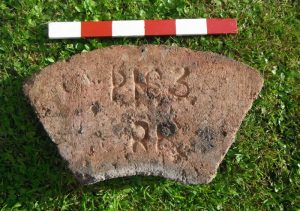Found Gartliston Works, Glenboig.
This was found at the P & M Hurll works at Gartliston and as such, I believe it to be one of their products.
Garnqueen Fireclay Works, Glenboig, Lanarkshire
Alternative brickworks include:
- Gartliston Fireclay Works, Glenboig, Lanarkshire.
Building bricks at Garscadden Works, Drumchapel.
Further, I believe that JBR 1 may stand for the Jodhpur-Bikaner Railway, Rajasthan, India.
The Jodhpur–Bathinda line connects Jodhpur, in the Indian state of Rajasthan to Bathinda in the Punjab. During the British Raj, Bathinda was on the Delhi-Karachi line and after independence and partition of India in 1947, it is on the Delhi-Fazilka line. This line operates under the jurisdiction of North Western Railway. Source WIKI
Indian Railway Systems
****************************
In 1888 the Political Officer of Bikaner sate drew up a plan of railway construction to open the interior areas of the state of Jodhpur and Bikaner to increase trade and commerce. The British Government was anxious to connect the Indus Valley with Rajputana states and therefore approval to the proposal of Jodbpnr-Bikaner Railway was easily given. The B.B.C.&C.I. Railway also promised not to enter into competition with the planned railway. At this time Bikaner was under minority administration; therefore the political agent’s scheme was not opposed by anyone in the state. The Resident at Jodhpur could easily persuade the Jodhpur Durbar to agree to the construction of Jodhpur-Bikaner railway especially when Bikaner was ready to advance to Jodhpur a sum of Rs. 20 lacs @ 4% interest. The repayment was also assured to Bikaner by the British Government out of the annual Salt royalty payments falling due to Jodhpur. Jodhpur had no objection to this railway project. Jodhpur had experience of the profitable working of the railway and thought of a greater return to the State from the proposed railway. After some discussion, the two States agreed to cede full civil and criminal jurisdiction over the land occupied by the railway to the Government of India whenever the latter considered it desirable. Separate agreements were executed by the two states in 1889. The management of the railway was entrusted to the manager. Jodbpur Railway was to begin from the Jodhpur side. It was to be opened to inspection at all times by an officer of the Government of India. The two states shared the running expenses as also the profits of the railway within their respective territories. The Jodhpur-Bikaner railway began in 1889. Its length in Rajputana was 700 miles, 455 belonging to Jodhpur and 245 to Bikaner and 124 additional miles, situated in British territory, were under the same management.
The line started from Marwar junction on the Rajputana-Malwa system and ran north-west for 44 miles till it reached the Luni river, whence there were two branches, one almost due west to Hyderabad (Sind), where it met the North-Western Railway, and the other generally north-by-north-east past Jodhpur, Merta Road, and Bikaner to Bhatinda in the Punjab. From Merta Road, another branch ran east, joining the Rajputana-Malwa line at Kuchaman Road, not far from the Sambhar Lake. The Jodhpur-Bikaner Railway was constructed gradually between 1881 and 1902, and the total capital outlay of the two States to the end of 1904 was about 173 lakhs; in the year last mentioned the net receipts exceeded 13.5 lakhs, thus yielding a return of nearly 8 per cent on the capital outlay.
The average return of Jodhpur Railway was about 10% on the capital outlay. In 1906 the gross working expenses were about 42% of the gross earning, a far more economical working than the management established by railway, companies or by British Govern¬ment. The earning from the Rajputana-Malwa railway during 1877-85 were not able to meet the operational expenses plus guaranteed interest on capital invested in railway construction. The Jodhpur-Bikaner Railway proved to be very useful during the famine of 1899-1900 and prevented a greater loss of life and cattle. Besides, opening up a new area British trade and commerce, it certainly acted as a helping auxiliary to mop up the marketable agricultural produce consequent upon land revenue settlements introduced under British supervision. It brought the agricultural population of both States under imperial policies; it also led to an increased trade in British goods in the region.












